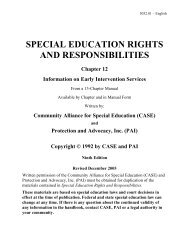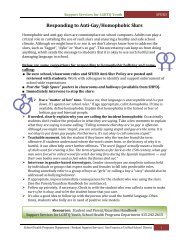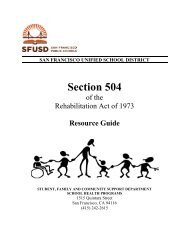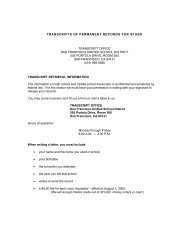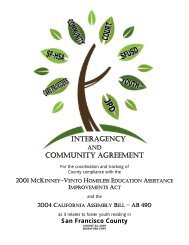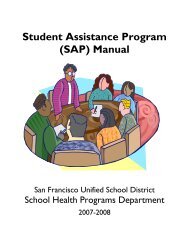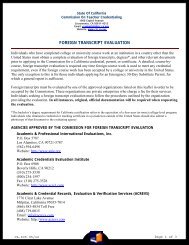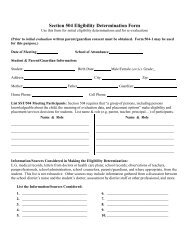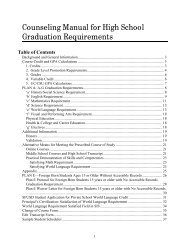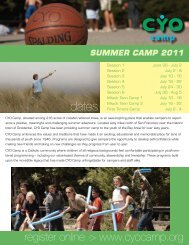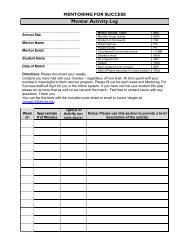2011 High School YRBS Results
2011 High School YRBS Results
2011 High School YRBS Results
Create successful ePaper yourself
Turn your PDF publications into a flip-book with our unique Google optimized e-Paper software.
ABOUT THIS REPORTAcknowledgements. Our special thanks go to all the SFUSD high school students who tookthe time to complete the surveys so that we might better understand how to reduce futurehealth risks and support student achievement. In addition, our sincere thanks to all theprincipals, teachers, and other school personnel who facilitated the administration of thesurveys.This project was funded by the Centers for Disease Control & Prevention (CDC), CooperativeAgreement 1U87DP001177-01, the California Department of Education (CDE), and the SanFrancisco Unified <strong>School</strong> District‘s Student, Family, and Community Support Department(SFCSD). Education, Training & Research Associates (ETR) managed the administration of thesurveys and produced this booklet in collaboration with SFCSD.About the <strong>Results</strong>. The <strong>YRBS</strong> results presented in this booklet have been statistically weightedand are representative of all students in grades nine through twelve attending public highschools in San Francisco. CHKS results, which are not weighted, are representative of 9 th and11 th grade students only. In this booklet, information about health risk behavior comes fromthe <strong>YRBS</strong>, while information about youth development assets and resiliency comes from theCHKS.About the Youth Risk Behavior Survey (<strong>YRBS</strong>). The <strong>YRBS</strong> was developed in 1990 by the Centersfor Disease Control and Prevention (CDC) to monitor priority health risk behaviors thatcontribute to the leading causes of death, disability, and social problems among youth andadults in the United States. These behaviors, often established during childhood and earlyadolescence, include: (1) violence and unintentional injuries; (2) tobacco use; (3) alcoholand other drug use; (4) sexual behaviors; (5) diet and weight management; and (6) physicalactivity.The <strong>2011</strong> <strong>High</strong> <strong>School</strong> <strong>YRBS</strong> was administered to a random sample of 2,220 students in gradesnine through twelve in 20 public high schools in San Francisco. The overall response rate was74%. Based on guidelines from the CDC, response rates of 60% or greater are consideredgeneralizable to the population from which the sample was drawn. More information aboutthe <strong>YRBS</strong> can be found at www.cdc.gov/yrbs.About the California Healthy Kids Survey (CHKS). The CHKS was developed under contractfrom CDE by WestEd in collaboration with Duerr Evaluation Resources, assisted by anAdvisory Committee of researchers, teachers, school prevention and health programpractitioners, and public agency representatives. The Healthy Kids Survey is a youth selfreportdata collection system that provides essential health risk assessment and resilienceinformation to schools, districts, and communities.The <strong>2011</strong> <strong>High</strong> <strong>School</strong> CHKS was administered to 5,622 students in grades nine and eleven in21 public high schools in San Francisco. More information about the CHKS can be found atwww.wested.org/chks or www.healthiersf.org.SFUSD <strong>High</strong> <strong>School</strong> Health Survey <strong>Results</strong> <strong>2011</strong> P a g e | 1



